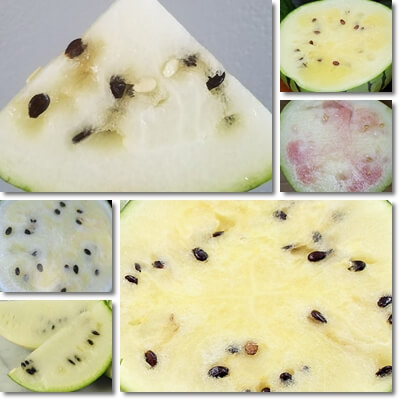Is your watermelon white inside? No worries. White fleshed watermelon fruit exist and are just as sweet and flavorful as the more common red watermelon varieties, and similarly nutritious. Perfectly edible and safe to eat in its entirety, white watermelon provides good amounts of vitamin C and citrulline, and small amounts of other essential vitamins and minerals. Eating white watermelon is good for you if you have high blood pressure and provides vasoprotective, diuretic and anti-inflammatory properties.
White watermelon has tonic, energizing effects and helps regulate transit and relive constipation.
What does it mean when watermelon is white inside?
If your watermelon is white inside, then that makes it a white watermelon. As its name so aptly indicates, white watermelon is a variety of sweet watermelon with white flesh. It’s the same botanical fruit as red watermelon, just white inside.
The white flesh color actually means the watermelon lacks pigments, hence the discoloration. Red watermelon is red inside thanks to a high content of the carotene lycopene. Yellow watermelon is yellow inside as a result of a higher content of xanthophylls such as lutein, neoxanthin, violaxanthin and neochrome. While orange watermelon is orange thanks to a high content of carotenes such as beta-carotene. Lacking these natural pigments completely or almost completely, white watermelon develops little to not color inside.
Find out more about what is white watermelon.

What does white watermelon look like?
White watermelon is oblong or rounded, with a light green rind with darker green lightning-like stripes running along its length, or a more uniform dark green rind. The flesh inside is either completely white or cream-colored, or white or cream with some degree of pink, especially towards the center where the seeds are. White watermelon seeds are cream colored when immature, and brown to black with a hard outer shell and milky white kernel when mature.
Is white watermelon safe to eat?
Don’t let yourself get put off by the color – white watermelon is edible and perfectly safe to eat in its entirety. You can eat white watermelon flesh, seeds and even the green rind with the white part of the watermelon rind too, with the mention that the green rind should be cooked or dried and finely ground to render it edible.
What does white watermelon taste like?
White watermelon should taste sweet, with pleasant fruity flavors. Go for varieties such as White Sugar Lump, White Wonder, Cream of Saskatchewan and Japanese Cream-Fleshed Suika which are reported to have the sweetest taste.

White watermelon nutrition
White watermelon is a good source of vitamin C at roughly 10% of daily requirements of the vitamin per 100 g serving. The white fleshed variety is a modest source of vitamins B1, B2, B5 and B6, iron, magnesium, manganese, phosphorus and potassium, and sodium free. Like other colors, white watermelon is very low in calories, with only about 30 kilocalories per 100 g serving. Water content is at over 90%, while fat and protein at 0.6% and 0.15%.
White watermelon has only 7.5 – 8 g of carbs per 100 g of fruit, about 6 g of which are sugars. The white flesh is a source of colorless antioxidants, and only trace amounts of lycopene and other carotenoids (even if it does not seem it has any). The green rind and the white part of the watermelon rind contain citrulline with scientifically proven blood pressure lowering properties and other circulatory benefits.
See the benefits of citrulline.
White watermelon benefits
- Benefits for high blood pressure owed to magnesium, potassium and citrulline in the white part of the rind and green rind. Also sodium-free.
- Vasoprotective properties and benefits for blood circulation from citrulline which stimulates the production of arginine used for the synthesis of nitric oxide.
- Diuretic properties, increasing urine output as a result of a high water content (over 90%).
- Benefits for kidney health, supporting kidney function and detoxification processes.
- Combats headaches, dizziness, tiredness and fatigue caused by dehydration.
- Good food for losing weight thanks to a low calorie, low-carb and moderate sugar content.
- Anti-hypoglycemic effects, helping raise low blood sugar levels.
- Good food to eat with diabetes: although it’s high glycemic index (GI score: 72), white watermelon is low glycemic load (GL score: 5) which means diabetics can eat it in moderation.
- Anti-inflammatory food: helps reduce inflammation markers in the body via a good vitamin C content.
- Minor benefits for teeth and gums owed to a good vitamin C content.
- Immune-boosting properties owed to vitamin C and other antioxidants and bioactive components with free radical-scavenging, anti-inflammatory and reparative effects.
- Minor benefits for anemia owed to a modest content of vitamins B1, B2, B5 and B6 and iron which support red blood cell production and muscle oxygenation.
- More vitality and instant energy thanks to a high water content, a reasonable content of natural sugars, electrolytes such as calcium, magnesium, potassium, and B vitamins and iron.
- Combats constipation thanks to a high water and modest fiber content which regulate transit, soften stools and promote easy and regular bowel movements.
White watermelon side effects
White watermelon is a safe food to eat, and it’s rare to experience side effects. One of the biggest side effects is contracting food borne illness if the rind of the watermelon is contaminated.
To prevent this, wash your watermelon well with soap and water in the skin and tap it dry with paper towels. This ensures you won’t contaminate the flesh with potential pathogens from the rind when cutting the watermelon to eat it.
